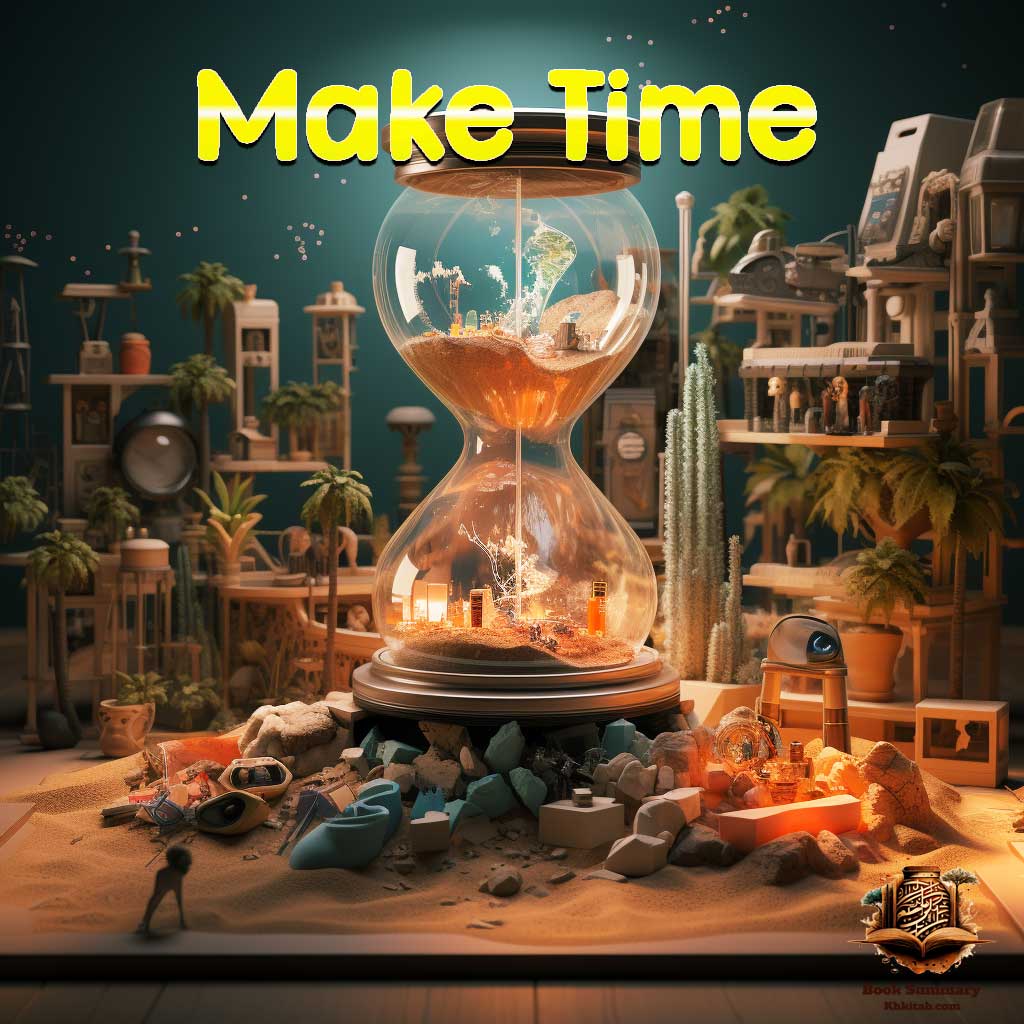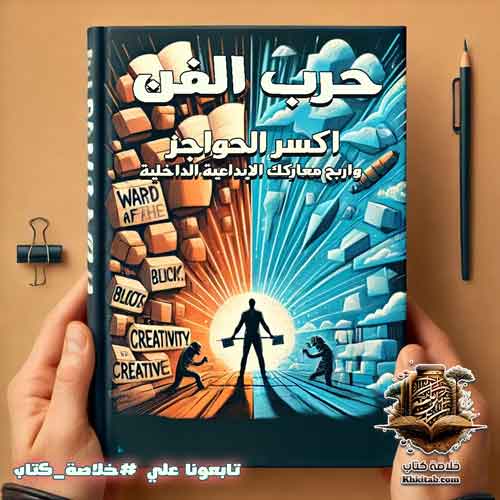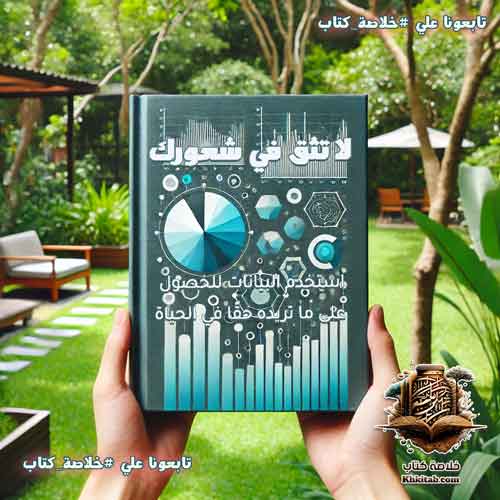Make Time: How to Focus on What Matters Everyday Book Summary

In today’s digital age, it often feels like time slips through our fingers as we find ourselves inundated with daily distractions, whether from smartphones, social media, or the incessant demands of work. Against this backdrop, “Make Time: How to Focus on What Matters Every Day” by Jake Knapp and John Zeratsky emerges, offering innovative strategies and methods to better manage our time.
This book is not just a mere guide to time management. Instead, it encourages readers to re-evaluate their priorities and identify what truly matters in their daily lives. The authors propose that we move beyond simple to-do lists and focus on what genuinely resonates with us. Through a daily framework built upon four fundamental steps, the book invites us to pinpoint the essential elements of our day, hone in on them, maintain our energy, and finally, reflect on our actions.
“Make Time” is an invitation to embrace a new philosophy of life, granting ourselves the opportunity to live with greater awareness and a deeper appreciation for what truly matters.
إقرأ أيضا:ملخص كتاب عظماء في طفولتهم للدكتور محمد المنسي قنديلHow Has the Modern Time Crisis Impacted Our Ability to Prioritize?
In our fast-paced digital age, the struggle to manage our time and maintain focus on what truly matters has become increasingly challenging. “Make Time: How to Focus on What Matters Every Day” delves deep into this challenge, particularly in its exploration of the ‘Time Crisis.’
The ‘Time Crisis’ refers to the overwhelming sensation of having too much to do and too little time to do it, which many of us feel on a daily basis. This sense of perpetual busyness is exacerbated by the myriad of distractions in modern life. Whether it’s the incessant ping of notifications, the allure of social media, or the constant flow of emails, these distractions fragment our attention, preventing us from dedicating time to our core priorities.
But what’s the root cause of this crisis? The authors argue that the current digital landscape, with its emphasis on ‘always-on’ culture, has restructured our lives in a way that makes focus elusive. Our brains are hardwired for novelty, and the digital world delivers that in abundance, feeding our propensity for distraction. The irony is, while technology promises to simplify our lives, it often adds layers of complexity that can make us feel overburdened and overwhelmed.
Moreover, the societal emphasis on multitasking, while seen as a strength, can further dilute our attention, making it hard to accomplish tasks to the best of our abilities. We end up juggling multiple tasks but not truly engaging or excelling in any.
In “Make Time,” the emphasis is on recognizing the pitfalls of modern life that contribute to the Time Crisis and strategizing to navigate through them. By being aware of these distractions and intentionally reshaping our day-to-day interactions, especially with technology, we can reclaim our time, refocus on our genuine priorities, and lead more fulfilling lives.
Our Facebook Page – Book summary
Why is Highlighting a Single Task Daily Crucial for Productivity?
In the era of constant connectivity and an overwhelming influx of tasks, the art of focusing becomes essential. One of the transformative concepts presented in “Make Time: How to Focus on What Matters Every Day” is the notion of ‘Highlighting.’ This idea gravitates around dedicating oneself to one significant activity or task daily, making it the day’s focal point.
So, why is this strategy so crucial? Highlighting serves as an anchor in the turbulent sea of daily tasks and to-dos. By designating one specific task as your highlight, it ensures that even on the busiest of days, there’s at least one task you’re committing to complete or make significant progress in. It’s a way of saying, “No matter what, this is the task I will give my undivided attention to today.”
The modern workspace, digital or otherwise, bombards us with diverse tasks, from emails requiring immediate attention to meetings that eat into our productive hours. Amidst this chaos, it’s easy to become reactive, addressing the loudest demand rather than the most significant one. The act of highlighting forces us to pause, reflect, and prioritize. It reintroduces intentionality into our daily routines.
Moreover, by consistently practicing highlighting, we train our brains to recognize what truly matters, gradually building a habit of discerning the vital few from the trivial many. This daily commitment not only ensures progress in meaningful tasks but also offers a sense of accomplishment and satisfaction, knowing that amidst the noise, you focused on what truly mattered.
In essence, highlighting is more than just selecting a task; it’s a commitment to oneself and one’s priorities. It’s a step towards reclaiming control in a world that constantly attempts to scatter our attention. By adopting this practice, as recommended in “Make Time,” individuals can navigate their days with more purpose, clarity, and fulfillment.
Self-development – Book Summary (khkitab.com)
How Can “Make Time” Techniques Propel You Toward Laser Focus in a Digitally Distracted World?
Living in an age of incessant digital notifications, our concentration is perpetually tested. “Make Time: How to Focus on What Matters Every Day” introduces invaluable techniques for cultivating a laser-like focus, allowing us to stand tall amidst a hurricane of digital distractions.
Firstly, one must acknowledge the allure of these distractions. Apps, websites, and digital platforms are expertly designed to capture and sustain our attention. Recognizing this is the first step in regaining control. The book presents a strategy dubbed “Redefining your Default Settings.” This means adjusting the settings on our devices to be less interruptive: turning off non-essential notifications, setting designated check-in times for emails, and even, in some cases, deleting particularly distracting apps.
Another pivotal tactic introduced is “Creating Barriers to Distraction.” Just as it sounds, this involves setting up physical and digital barriers between oneself and potential disruptions. For instance, using apps that block access to distracting websites during work hours or placing the phone in a different room while focusing on a task.
Furthermore, “Make Time” underscores the importance of “Mindful Technology Usage.” Instead of mindlessly scrolling through social media or websites, it advises deliberate and purposeful interaction with technology. Setting clear objectives before using a device, like replying to specific emails or watching a particular video, can drastically reduce the time spent on unproductive activities.
But it’s not all about avoidance. The book also emphasizes the role of rejuvenating breaks, known as “Energy Boosters.” These are moments in the day where one engages in non-digital activities that refresh the mind, like taking a walk, practicing deep-breathing exercises, or even enjoying a short nap. Such breaks recalibrate the mind and prepare it for focused work.
To summarize, achieving laser focus in today’s world requires both proactive strategies and intentional breaks. “Make Time: How to Focus on What Matters Every Day” offers a comprehensive guide to navigating the labyrinth of digital distractions, ensuring that we dedicate our attention to what truly matters. In implementing these tactics, not only will your productivity soar, but your mental well-being will flourish in a world where attention is the most precious commodity.
How Can We Navigate the “Infinite Pools” of Distractions in the Digital Age?
Living in the digital era, we’re constantly surrounded by what the “Make Time” authors, Jake Knapp and John Zeratsky, label as “Infinite Pools”. These are the endless sources of distractions, such as social media, email, and 24/7 news cycles, that can quickly consume our hours, days, and even our well-being. However, by understanding their nature and adopting smart strategies, we can reclaim our time and focus.
Firstly, it’s imperative to acknowledge the pull of these “Infinite Pools”. Designed to keep us engaged, platforms like social media employ various techniques, from autoplay videos to endless scrolling, ensuring we stay longer and engage more. Recognizing these design intentions is the first step towards breaking free. The constant flow of emails and the allure of breaking news updates can similarly draw us in, making us feel like we’re always missing out if we’re not connected.
To counteract this, “Make Time” suggests a few strategies. One approach is to set specific times for engaging with these platforms. For instance, allocate specific “check-in” periods for email or social media during the day, and stick to them. This not only prevents constant interruption but also allows for dedicated focus during other times.
Another effective strategy is to change the environment. Remove apps from the home screen, turn off non-essential notifications, or even consider using apps or tools that block access during certain periods. The less accessible these “pools” are, the less likely we are to dive in mindlessly.
Lastly, taking regular digital detoxes can be immensely beneficial. Whether it’s a few hours in a day, a weekend, or even a longer break, time spent away from screens allows for mental rejuvenation. It’s during these breaks that we often find clarity, come up with new ideas, and remember what’s truly important.
In conclusion, while the “Infinite Pools” of the digital age are powerful, they’re not insurmountable. With understanding and intentionality, as advocated by “Make Time”, we can navigate these waters without being swept away, ensuring that our time is spent on what genuinely matters.
How Does Energy Maintenance Shape Our Productivity and Focus?
In the groundbreaking book “Make Time: How to Focus on What Matters Every Day,” the authors, Jake Knapp and John Zeratsky, delve into the intricacies of optimizing both mental and physical energy as cornerstones of productivity. They believe that without maintaining these two forms of energy, the best time management strategies can still fall flat.
The modern world has a plethora of distractions and tasks that continually drain our mental and physical reserves. The book underscores the importance of recognizing when our energy is waning and, more crucially, understanding the strategies and habits that can either deplete or replenish these reserves. For instance, while one might assume that constant engagement with work-related tasks maximizes productivity, the book reveals that this incessant engagement can be counterproductive. Continual work without breaks, especially on tasks requiring high cognitive loads, can lead to rapid burnout, reduced focus, and impaired decision-making.
Moreover, “Make Time” also stresses the importance of physical well-being. This isn’t merely about regular exercise, though that plays a significant role. It’s also about understanding the types of food that fuel our bodies efficiently, the benefits of adequate hydration, and the undeniable rejuvenating effects of a good night’s sleep. These physical elements are intertwined with our mental capacity; one cannot function at its peak without the other.
Lastly, the authors introduce practical techniques and rituals to incorporate into our daily routines. From short, focused bursts of work followed by deliberate breaks, to setting aside “highlight” tasks that deserve our utmost attention and energy, the strategies provided are both actionable and designed for the realities of today’s fast-paced world.
In essence, “Make Time” doesn’t just offer tools to manage hours and minutes; it provides a holistic approach to harnessing and maintaining energy, ensuring that every moment we invest is backed by the full strength of our mental and physical prowess.
How Can Daily Reflections Elevate Your Focus and Productivity?
In the influential book, “Make Time: How to Focus on What Matters Every Day”, authors Jake Knapp and John Zeratsky present an intriguing concept: the power of daily reflection. Beyond mere time management techniques, they emphasize the essence of evaluating our day-to-day experiences to fine-tune our strategies for even better results.
In today’s hyper-paced world, it’s easy to get caught up in the whirlwind of tasks, meetings, and demands. However, one of the major pitfalls of such a lifestyle is failing to pause and assess. This is where daily reflections come into play. According to Knapp and Zeratsky, it’s not just about cramming tasks into a day, but understanding the value and effectiveness of those tasks.
A daily reflection serves multiple purposes:
- Awareness of Accomplishments: It offers a chance to recognize and celebrate successes, no matter how small. This fosters positivity and motivation.
- Understanding Pitfalls: Not every strategy or approach we adopt is foolproof. Reflection helps in identifying what didn’t work, which is the first step in making necessary adjustments.
- Setting Intentions: By reflecting on the day’s outcomes, one can set clear intentions for the next day. This act of forward-thinking ensures that you’re not just reacting to the day, but proactively shaping it.
- Emotional Regulation: Reflection allows for the processing of emotions tied to particular events or tasks. By understanding and acknowledging these emotions, one can approach tasks with a clearer and calmer mindset.
Moreover, “Make Time” underscores the importance of making reflection a ritual, rather than a sporadic activity. Just like brushing our teeth or having breakfast, reflecting at the end of the day should become second nature. This consistency ensures that you’re constantly in a state of growth and adaptation.
To integrate this into our daily routine, the authors suggest setting aside a specific time for reflection, away from digital distractions. It could be a few quiet moments before bed, or maybe during a late evening walk. The key is to find a tranquil space where one can genuinely connect with their thoughts.
In conclusion, “Make Time: How to Focus on What Matters Every Day” doesn’t merely offer time management tips. It presents a holistic approach to living a purposeful life. Daily reflection, as the book posits, is a cornerstone of this approach, ensuring that each day isn’t just filled with tasks, but with meaningful, intentional actions.
How Can Experimentation Lead to Personalized Productivity Strategies?
In “Make Time: How to Focus on What Matters Every Day”, authors Jake Knapp and John Zeratsky delve deep into the art and science of making the most out of our days. A pivotal concept they introduce is the power of experimentation. They emphasize that the journey to true productivity isn’t about adopting a monolithic system, but rather it’s about discovering what uniquely works for you.
Why is Experimentation Important?
- Personalization: Everyone is different. What works wonders for one person may be utterly ineffective for another. Through experimentation, you can discover strategies that align with your personal rhythms, habits, and preferences.
- Flexibility: The world changes, and we change with it. By adopting a mindset of experimentation, you’re more adaptable and can shift your strategies as needed to better suit new circumstances or life changes.
- Learning from Mistakes: Not every tactic will be a winner, and that’s okay. Experimentation allows you to learn from what didn’t work, refine your approach, and inch closer to a system that genuinely benefits you.
- Enhanced Engagement: Experimentation keeps things fresh. It adds a layer of excitement and curiosity to your daily routines. Instead of feeling trapped in a rigid system, you’ll be invigorated by the possibility of finding even better ways to manage your time.
How to Start Your Productivity Experimentation:
- Set Clear Objectives: Know what you want to achieve. Whether it’s better focus, less procrastination, or more free time, having clear goals will guide your experiments.
- Document Everything: Keep a journal of what you’re trying out, how it’s making you feel, and the results you’re seeing. This documentation will be invaluable in helping you determine what’s working and what’s not.
- Iterate: Once you’ve tried a strategy for a while, assess its effectiveness. If something isn’t working, tweak it, or try something entirely different.
- Stay Open-minded: The key to successful experimentation is an open mind. Be willing to abandon tactics that aren’t serving you, even if they’re widely recommended by others.
In conclusion, “Make Time: How to Focus on What Matters Every Day” offers a refreshing take on productivity by stressing the importance of tailoring strategies to fit one’s unique needs. By embracing experimentation, we can forge our paths to a more productive and fulfilling day. So, ask yourself, are you ready to start experimenting with your time?
How Can Redesigning Workspaces Boost Your Productivity and Focus?
Within the enlightening pages of “Make Time: How to Focus on What Matters Every Day”, Jake Knapp and John Zeratsky shed light on a crucial yet often overlooked component of productivity: the design of our workspaces. Be it digital or physical, the environment in which we operate plays a pivotal role in shaping our focus, efficiency, and overall work experience. Let’s delve deeper into the key takeaways from this insightful segment of the book.
Understanding the Importance of Workspace Design:
- Physical Spaces: The layout of our desks, the lighting in our rooms, and the noise levels around us significantly influence our cognitive processes. A clutter-free, well-lit space with a comfortable seating arrangement can greatly enhance focus and creativity.
- Digital Spaces: Much like our physical environment, our digital workspace – the state of our desktops, the organization of our files, and the apps we use – can either be a source of distraction or a tool for efficiency.
Implementing Positive Changes:
- Declutter Regularly: Both in the physical and digital realm, it’s essential to regularly declutter. This means removing unnecessary items from your desk, closing unused tabs, and uninstalling distracting apps.
- Opt for Ergonomic Furniture: Investing in ergonomic furniture can not only improve posture but also boost productivity by providing comfort during long work hours.
- Digital Hygiene: Organize your files into clear, logical folders. Use tools that block distracting sites during work hours and set specific times to check emails and notifications.
The Psychological Impact of Workspace Design:
- Motivation Boost: A clean and organized workspace can serve as a motivation booster, compelling individuals to work with a renewed sense of purpose.
- Reduction in Stress: Searching for files in a messy digital folder or operating in a cluttered physical space can be stress-inducing. An organized workspace alleviates such unnecessary stressors.
- Enhanced Creativity: A well-designed space, be it physical or digital, can inspire ideas and foster creativity.
Continuous Evolution:
- Just as the world of work is ever-evolving, so should our workspaces. Regularly reassess and adapt your workspace to suit your changing needs and to incorporate new productivity tools or methods.
In conclusion, “Make Time: How to Focus on What Matters Every Day” is not just about managing time; it’s about optimizing all facets of our work environment. By giving due attention to redesigning our workspaces, we pave the way for a more productive, focused, and enjoyable work experience. Whether you’re an entrepreneur, a student, or a professional, taking the time to assess and revamp your workspace could be a game-changer in your daily routine.
How Can Mindful Technology Use Enhance Our Daily Productivity and Focus?
In the era of technology-driven distractions, “Make Time: How to Focus on What Matters Every Day” by Jake Knapp and John Zeratsky delves deep into a critical concept: Mindful Technology Use. The book underlines the fact that while technology offers a plethora of benefits, it can also easily deviate us from our primary goals and tasks. Let’s unpack the main ideas surrounding this theme:
Understanding the Tech-Landscape:
- Modern technology, especially smartphones and apps, is designed to grab our attention. The endless cycle of notifications and the allure of social media can easily swallow hours of our time, often without us realizing it.
Setting Clear Boundaries:
- To ensure technology serves us, it’s pivotal to set clear boundaries. This might mean allocating specific times of the day for checking emails or social media and sticking to them.
- Using tools or apps that limit screen time or restrict access to distracting sites can be beneficial. These tools act as digital gatekeepers, ensuring you only access the information you need, when you need it.
Being Intentional with Tech Choices:
- Not all technology is distracting. Choose tools and apps that align with your goals. For instance, if you aim to read more, an app like Audible might be beneficial. However, if you’re trying to focus on a project, maybe it’s time to log out of Twitter.
- The key is to curate your tech environment just as you would your physical one.
Taking Tech Breaks:
- Just as we need breaks from work to rejuvenate, our minds also need breaks from the constant barrage of digital information.
- Periodically disconnecting from technology, even if it’s just for a short time each day, can help in resetting our minds and bringing about a fresh perspective when we return.
Mindful Consumption Over Mindless Scrolling:
- Instead of endlessly scrolling through social media or news sites, be more intentional. Choose quality content that adds value to your life or helps you towards your goals. Subscribe to a few quality newsletters or blogs and dive deep into them rather than skimming the surface of many.
Recognizing Tech’s Role in Life:
- Technology, at its best, can enhance our lives, making tasks easier and connecting us with loved ones. Recognizing and appreciating this can help in developing a more balanced relationship with it.
In conclusion, “Make Time: How to Focus on What Matters Every Day” is not just a manual for time management but a guide for leading a more intentional life in the age of digital distractions. By promoting mindful technology use, we can reclaim our time and focus, ensuring that we are in control of our devices, not the other way around. As we integrate technology further into our lives, understanding and practicing these principles becomes not just beneficial but essential.
How Can We Differentiate Between Urgent Tasks and Truly Important Long-term Goals?
In the book “Make Time: How to Focus on What Matters Every Day” by Jake Knapp and John Zeratsky, a profound emphasis is placed on understanding the difference between tasks that seem urgent and tasks that are genuinely important in the long term. Let’s dive into the primary ideas presented in the book regarding this critical distinction.
Defining Urgent vs. Important:
- Urgent Tasks: These are tasks that demand immediate attention and give the illusion that they are significant. They are often reactive tasks – responding to emails, attending unplanned meetings, or handling emergencies.
- Important Tasks: These are activities that contribute to our long-term mission, values, and goals. While they might not have immediate deadlines, neglecting them could have long-term consequences.
The “Infinity Pools” Concept:
- The authors introduce the idea of “infinity pools” – endless sources of content like emails, news, and social media that always have something new and often present themselves as urgent. Recognizing and regulating our time with these can help prioritize the truly important tasks.
The Highlight Strategy:
- Each day, choose a “highlight” – one significant task you want to focus on. This practice trains your brain to prioritize the essential over the urgent consistently.
Tactics to Reframe Your Priorities:
- Time Blocking: Allocate specific blocks of time in your day dedicated to your most crucial tasks, ensuring they get the attention they deserve.
- Setting Boundaries: Create dedicated periods where you’re disconnected from digital distractions, allowing deeper focus on the long-term tasks.
- Daily Reflection: At the end of each day, review what you accomplished. Recognize if you were swayed by urgent tasks and adjust your strategies for the following day.
The Importance of “White Space”:
- The book promotes the idea of having “white space” in your schedule – periods without specific tasks. This space allows for reflection, creativity, and often leads to insights about what’s genuinely important.
Understanding the Cost of Context Switching:
- Shifting between tasks, especially between urgent and important ones, can be mentally taxing. Understanding this cost can encourage a more intentional approach to task management.
In conclusion, “Make Time: How to Focus on What Matters Every Day” offers actionable insights and strategies to help readers discern between the immediate, often distracting tasks and the genuinely significant ones that align with long-term goals. By making this distinction and applying the book’s tactics, we can lead more productive and purposeful lives.








